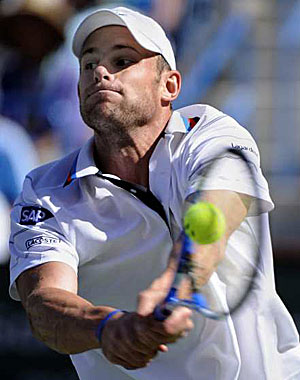 Before people get into a snit about the use of the word evolution, remember the word existed before the theory of evolution and has to with gradual change.
Before people get into a snit about the use of the word evolution, remember the word existed before the theory of evolution and has to with gradual change.
Tennis players, it seems, get to where they are because they learn to hit the tennis ball very well at a very young age. As their game improves through the juniors and as they turn pro, players learn to make adjustments to their games. It’s interesting to hear someone like Ivan Ljubicic, at the age of 31, who decides there’s not much more he needs to add to his game. He’s not going to learn a lot of new things. He simply lacks the time. He may as well focus on fitness, which is what he’s done.
This isn’t the case when a player is younger. They can try to make changes. For Rafael Nadal, he learned to hit a bigger serve, to use a slice backhand, to learn how to volley somewhat adeptly at net. He’s learned to play closer to the baseline.
Roger Federer improved his baseline game so he no longer had to rush to net all the time, and in fact, is learning to rush the net once more. He’s worked on making his backhand a bigger weapon. There are probably subtle changes in his game. His forehand has more of a wristy component than it did when he first got on tour where the shot resembled more Agassi than Nadal.
Let’s think about Roddick’s game. Here was a guy who was noted for his huge serve. It could easily be said that this serve launched Babolat. Companies like Babolat pay players to endorse their racquets for a reason. Pro players help sell racquets. Good news for Babolat–they make good racquets. So as Americans and other fans of Roddick wanted more pop on their serve, they bought his racquet.
Roddick also had a huge forehand and he would use this as a weapon to win points. So Roddick of the early 2000 was a big serve and a big forehand.
Look at his game today. How often does Roddick pull the trigger and go for a big shot? Even before he worked with Stefanki, Roddick had already decided to play a counter-puncher style, and a style that is now unusual for a clay courter. When you think of a clay courter today, you think Spaniard. Spanish players today play a relatively aggressive baseline game filled with topspin. They are willing to go for winners, sometimes more often than is needed (think: Fernando Verdasco). Rafael Nadal plays a combination of passive-aggressive tennis, a spinny shot that creates problems for his opponents. Even when he goes for a down-the-line shot, it’s not of the hard flat variety that most players hit, but of a fast spinny deep shot. It seems safe, even as it’s zipping along out of reach.
Roddick doesn’t even play that style. He’s rarely working his shots for winners. He’s accurate enough to hit the shot side to side, but his intention seems to be keeping his shots deep and making the shot uncomfortable. It is a flatter version of what Nadal does except, unlike Nadal, Roddick rarely gets his opponents into trouble which opens them up for winners. He’s hitting just flat enough that they mishit their shots a little long. It’s both oddly cerebral and yet looks like nothing at all.
This is key. Roddick has plenty of fans in the US and the world over, but ask them to point out what makes Roddick’s game work. Why does he win so much? Surely, it’s the serve, right? And yes, the serve is hugely important to Roddick, but he doesn’t hit nearly as many aces as he used to. Still, it’s that serve that allows him to hold more often that he doesn’t. If Murray had Roddick’s serve, especially his second serve, Murray might be a solid number 2, if not number 1. Murray’s improved his first serve, but he often flirts with a 50% first serve percentage while Roddick almost always floats close to 70%. Roddick, like Karlovic, has a good, but consistent first serve.
Roddick can use that first serve to set up a point. He often gets 2 free points a game, which is huge at the pro level. he does have to work hard to win his other points, but he’s generally capable of it. Roddick’s game, it must be said, would be nowhere without his serve. He is steady, but not dominant, like Nadal. Nadal has the virtue of having such a heavy ball that only the very best groundstrokers stay even with him. For example, when Nadal plays Isner, Isner often struggles to chase down Nadal’s ball. His footspeed doens’t currently let him chase shots down well. He’s not zippy like Murray or Davydenko or Federer.
Everyone talks about Roddick’s tenacity, but he needs a game to back that up. And that game is no longer predicated on hitting huge shots. Roddick’s game has become Nadal-like in its way, a flatter, deeper version without the threat of a big winner. Who would have thought that Roddick might be, perhaps, the purest counter puncher playing today.
One other note. Stefanki had wanted Roddick to play more net, and in his match against Soderling, Roddick appears to have cut that back down. He may selectively decide which opponents he will come to net against, or maybe he’s decided that he’ll never be a good enough net player, despite several other players trying to add a net component into their game (Djokovic, Federer, and, yes, even Nadal).




![[US Open Men’s Final] Can Djokovic beat Nadal in the finals?](https://www.essentialtennis.com/wp-content/uploads/2013/09/20130909djokovic-500x383.jpg)


![[French Open] The tactics of the Djokovic-Nadal semifinals](https://www.essentialtennis.com/wp-content/uploads/2013/06/20130607nole-500x383.jpg)